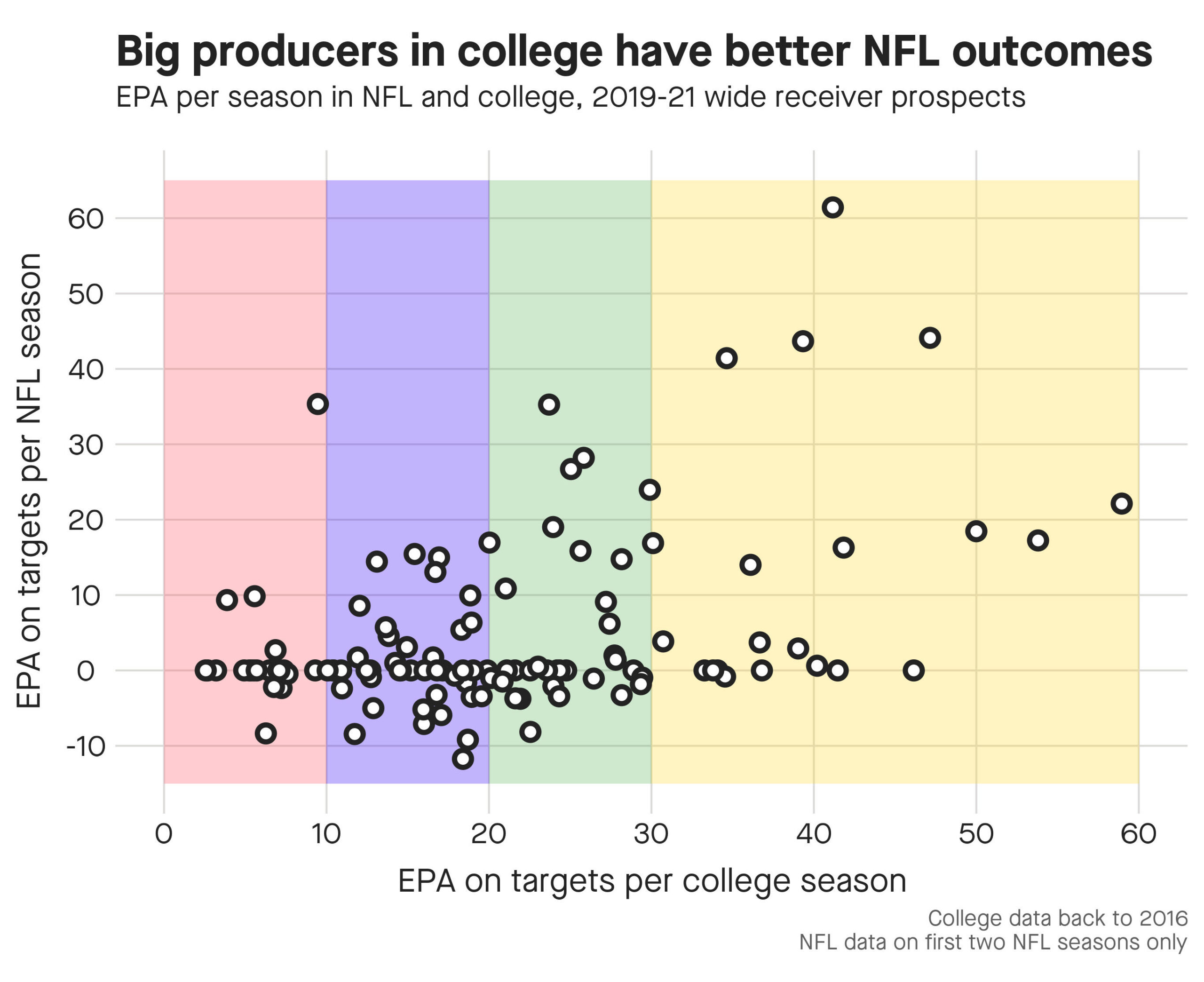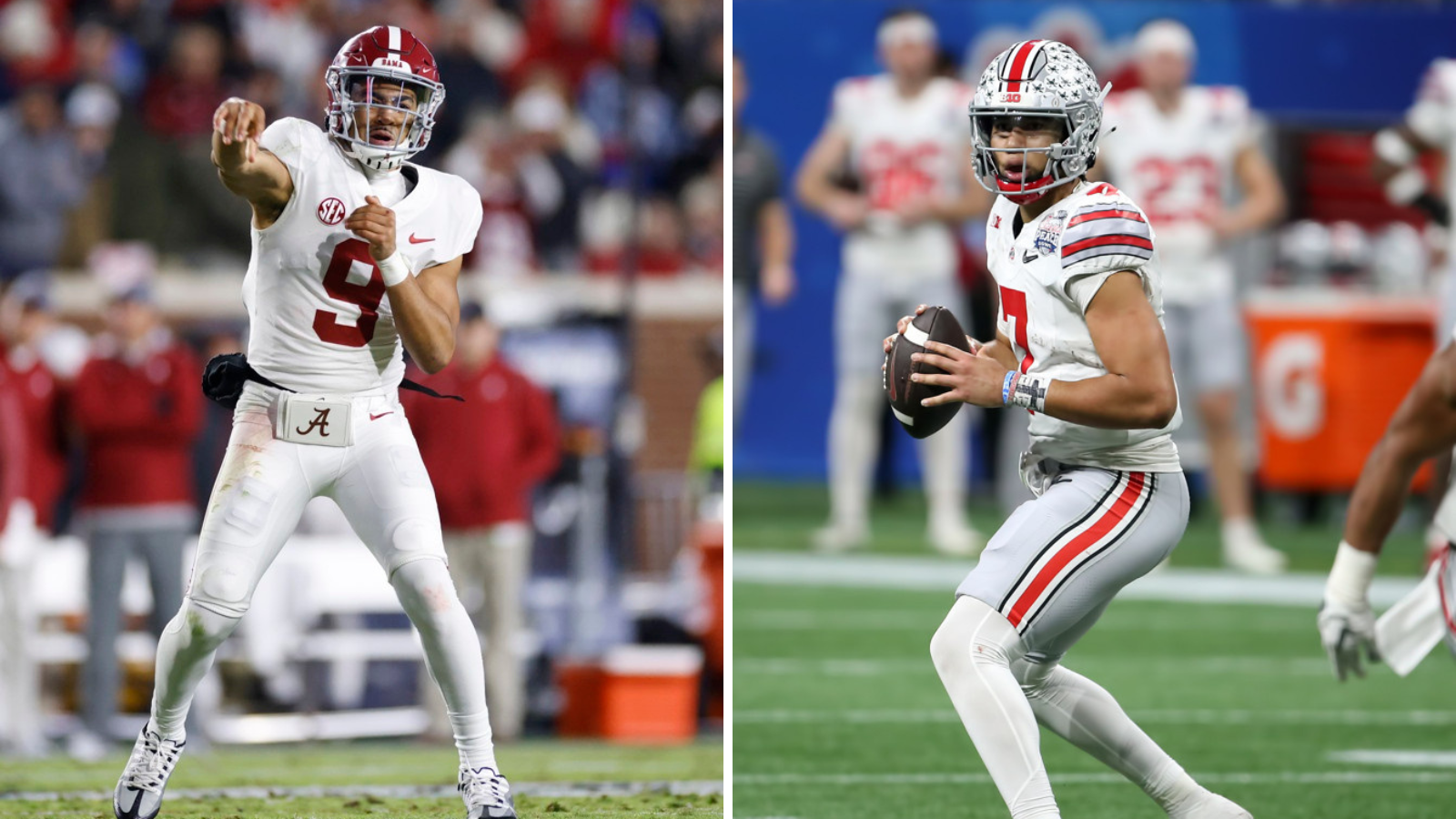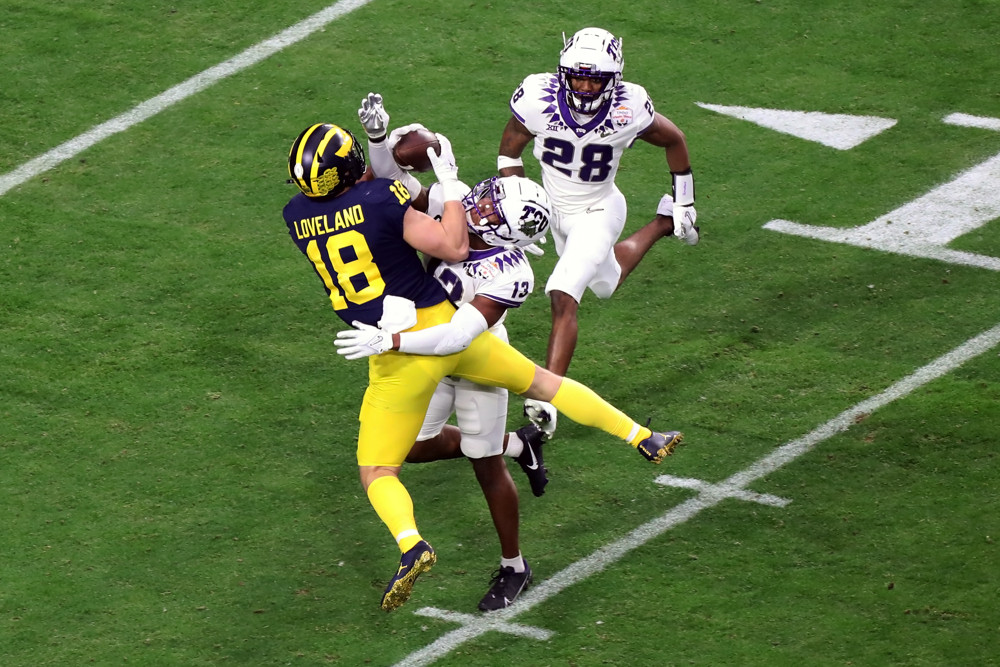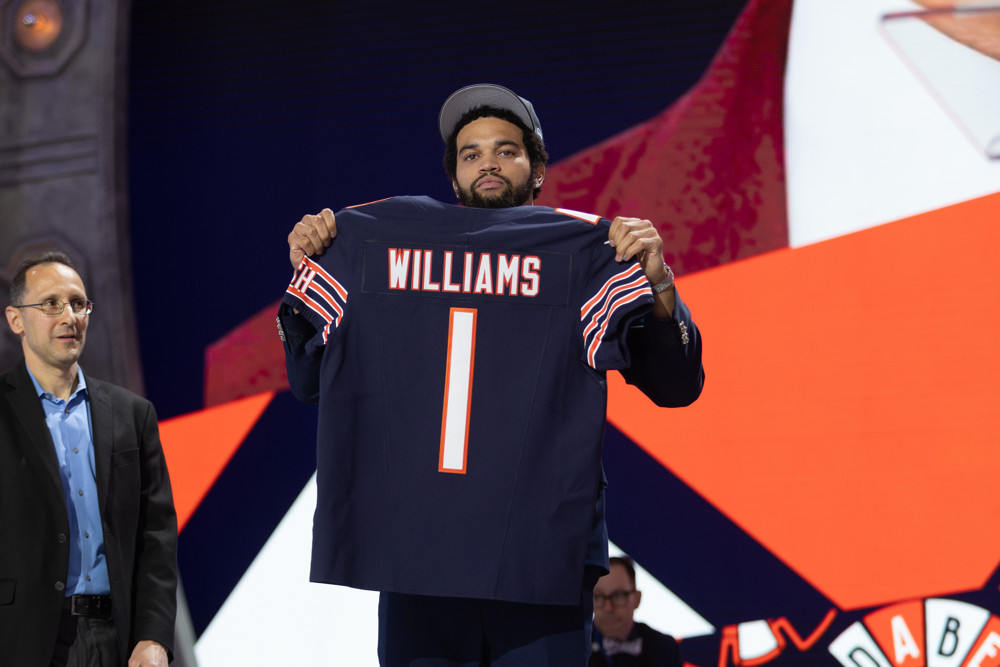The 2019-2021 NFL drafts have, among other things, put a spotlight on the wide receiver position heading into this draft.
Ahead of those drafts, that added attention has at least in part been a consequence of top prospects coming out of big-time programs like Alabama (DeVonta Smith, Jerry Jeudy, Henry Ruggs, Jaylen Waddle) and LSU (Justin Jefferson, Ja’Marr Chase). But the production generated from the position has also been outstanding.
This isn’t a true evaluation of talent, but one way of looking at the excellence of the current crop of young receivers is this: 12 of the 23 wide receivers in the first four tiers of FantasyPros’ rankings for 2022 were drafted in the first three rounds of the 2019-21 NFL drafts.
According to SIS scouts, this year’s group doesn’t have the same elite top-end that the previous two years did, but the starter-quality depth is there. Eight players have been given starting grades, which means you’ll likely see 10 or more go off the board before the end of the second round (as was the case the last two years).
Which members of the receiver class have production we’d want to bet on?
The SIS NFL Draft site has dozens of advanced statistics to evaluate receiver prospects, and a lot of them are specific to certain skills like hands, route running, and yards after catch. But if we want to identify which players we expect to succeed generally, it’s still best to rely on overall measures of production. We’ll start with that, and then take overall production within a particularly relevant split (against press coverage).
Setting the Scene with Production as a Whole
It shouldn’t shock anyone that production at the college level corresponds to production at the NFL level, but having some numbers behind that claim is useful.
Let’s take a look at recent prospects’ college production across their last few college seasons. We’ll use Expected Points Added (EPA) on targets per season at the college level, because that allows us to use multiple college seasons even for 2019 draftees. Ideally we would use our catch-all value metric Total Points—most notably because it does a better job of isolating what a receiver is accountable for—but that only exists going back to 2018.
Below is a breakdown of how EPA at the college level has projected to EPA at the NFL level. The players being considered are those whom SIS evaluated, which includes basically any player likely to be drafted.
Per-Season College and NFL EPA, 2019-21 Receiver Classes
| College EPA per Season | NFL EPA per Season |
| 0 – 10 | 2.1 |
| 10 – 20 | 0.9 |
| 20 – 30 | 5.0 |
| 30 or more | 14.6 |
And if you want a look at the individual results, here they are as well.

Getting above the 20 EPA per season mark in college suggests improved results at the NFL level—but getting above 30 is the real indicator.
Because players like Justin Jefferson skew the average, we might also consider just asking how many productive NFL players come out of each group.
Say we set that bar at an average of at least 20 EPA per season in the NFL—somewhere in the 800-yard, 6-TD range if you want to think of it that way. All but one of the 2019-21 draftees who have produced 20 EPA per season at the NFL level produced at least 20 EPA per season at the college level. DK Metcalf stands out as an exception, but he stood out as an exception during the draft process because of his crazy measurables.
These results should also be taken in tandem with scouting evaluations. Metcalf, for example, was still graded as a starter-quality prospect despite his lackluster production.
Several players have had outstanding production but less-outstanding traits on film, and in those cases the scouting report tells a valuable story. Eight players fell into that 30+ EPA group but were not graded as solid starters by SIS scouts. Only Diontae Johnson has worked out of that group.
Of the eight starter-quality prospects on the SIS draft board this year, two did not meet that EPA threshold: Justyn Ross of Clemson and George Pickens of Georgia. While this measure is taking into account their whole careers, recent injuries play a part in both cases. Pickens missed the majority of this season recovering from ACL surgery, while Ross was somewhat hampered play-to-play by a foot injury that eventually ended his season.
Beating Press Coverage
Yes, being productive in college is good. But as mentioned before, not all production is created equal. Like with quarterbacks and “NFL throws”, we want to be able to find the spots where a player is asked to do something more NFL-like than average.
Press coverage is one of those “NFL” things. Particularly in college, teams typically use it more if they have the personnel to get away with it. As a consequence, that also means that press coverage is a good bit less common than it is at the NFL level, which means it’s a situation that we want to focus on to better evaluate a prospect heading into the NFL.
If you can beat press coverage as a college receiver it likely means two things: you’re able to get off the line without being diverted from your route, and the defenders you’re facing are higher-quality on average than we’d assume just based on the overall team quality.
SIS has measured press coverage usage for the last three college seasons. We identify the alignment pre-snap but also the immediate action of the defender, so we can focus on plays where the defender stayed in press after the snap.
Take a look at the leaderboard below. Looking at only college prospects, we’ll take the players with at least 50 routes run when lined up outside against true press coverage over the last three college seasons. For this we’ll use Yards per Route Run as the measure of success. Press coverage is supposed to blanket the receiver and deter them from getting the ball, so we need a measure that captures non-targeted routes.
Yards per Route Run Against Press on the Outside, 2019-21 CFB
| Player | Draft Year | Y/RR |
| DeVonta Smith | 2021 | 4.6 |
| Ja’Marr Chase | 2021 | 4.2 |
| Cornell Powell | 2021 | 4.0 |
| Kyle Pitts | 2021 | 3.9 |
| Drake London | 2022 | 3.9 |
| Damonte Coxie | 2021 | 3.8 |
| Frank Darby | 2021 | 3.5 |
| Tee Higgins | 2020 | 3.5 |
| Dax Milne | 2021 | 3.3 |
| Quintez Cephus | 2020 | 3.1 |
Remembering that this leaderboard is subject to all the limitations of using college stats as a projection, this is a pretty encouraging record of success for players coming into the NFL, with Smith, Chase, Pitts, and Higgins primed to be top producers at their position.
For what it’s worth, the bottom 10 players in this stat have combined for under 1,000 career receiving yards (including first-round pick Jalen Reagor and 2021 preseason fantasy sleeper Terrace Marshall Jr.).
Let’s take this out of the anecdotal and into a more holistic measure. Here the group of prospects is split in half twice: once by their yards per route run against true press, and once by their yards per route run against everything else. And we’ll look at their overall Total Points per season in the NFL.
NFL Total Points per Season by CFB Performance vs. Press, 2019-21 prospects
| Bad vs. No Press | Good vs. No Press | |
| Bad vs. Press | 1.0 | 3.0 |
| Good vs. Press | 5.3 | 7.7 |
Being good against press is more relevant to NFL success than being good otherwise. You can tell because the differences between the rows in the table above are both larger than the differences between the columns.
Keep in mind that defensive backs aren’t pressing most of the time; we’re seeing college performance on a minority of snaps be a meaningful predictor of NFL performance overall.
If we turn our eyes to the top end of this year’s crop of prospects, that suggests good things for USC’s Drake London (SIS’s No. 6 WR) and some cause for concern for Alabama’s Jameson Williams (No. 2). Arkansas’ Treylon Burks barely faced press in college, which we might want to trust more than the insane production he generated against it.
Yards per Route Run Against Press, Top 2022 WR Prospects
| Player | School | SIS Grade | Routes | Y/RR |
| Treylon Burks | Arkansas | 6.9 | 22 | 9.7 |
| Jameson Williams | Alabama | 6.9 | 119 | 0.9 |
| Garrett Wilson | Ohio State | 6.8 | 147 | 1.9 |
| George Pickens | Georgia | 6.8 | 163 | 2.3 |
| Jahan Dotson | Penn State | 6.8 | 233 | 1.3 |
| Drake London | USC | 6.8 | 73 | 3.9 |
| Chris Olave | Ohio State | 6.7 | 152 | 2.4 |
| Justyn Ross | Clemson | 6.7 | 99 | 1.6 |
Of the names just beyond this list, David Bell (No. 14) did very well against press, while Christian Watson (No. 10) was much better when he wasn’t bumped at the line. (It’s worth noting that we don’t have all of Watson’s stats because he went to an FCS school.)
If you want to dig deeper and find players with backup grades who might have some upside, Calvin Austin III (No. 19) and Jack Sorenson (No. 47) are among the top performers against press. Sorenson is a fun test case for the interplay of scouting and statistics, because his lowest-graded skill in his scouting report is his release off the line. If he makes it to the NFL, it’s likely because he outperforms that grade.



